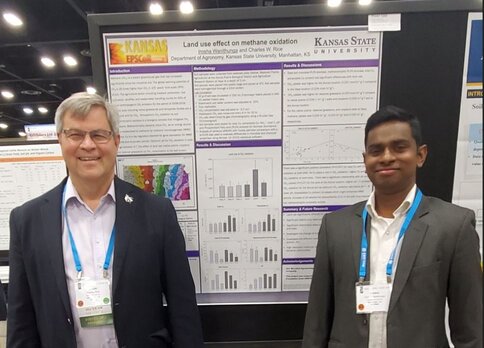
Originally from Sri Lanka, Irosha has always loved nature and the outdoors. As a result, his educational career focused on “topics related to natural sciences; specifically, the carbon cycle, soil-microbiota, greenhouse gas fluxes, biosphere, and climate change-related topics.” During his tenure as a Graduate Research Assistant in Agronomy at Kansas State University (KSU), Irosha “investigated the effect of three land-uses (native, restorative, agriculture) on soil microbial methane oxidation at two selected biological stations across the two distinct precipitation regimes in Kansas” as part of the Kansas NSF EPSCoR RII Track-1 Award OIA-1656006: Microbiomes of Aquatic, Plant, and Soil Systems across Kansas (MAPS). Irosha worked with Dr. Charles Rice, a Distinguished Professor of Soil Microbiology at KSU and Co-PI of the MAPS award.
Irosha conducted “a study to find the biotic and abiotic factors that affect methane oxidation in native tall grass prairie with ‘prescribe fire’ and found that changes in soil moisture contents, pH, and total soil Cu content had a significant effect on soil methane oxidation.” He said that each new finding in his research stimulated his curiosity to learn more about these topics.
The title of his master’s project is Land use effect on Methane Oxidation, and he explained his research as follows: “Methane (CH4) is one of the critical anthropogenic greenhouse gases that has increased significantly with the beginning of the industrial era. Methane oxidation by methanotrophic bacteria mitigates CH4 emissions. The effect of land use (native prairie, cropland, and restored grassland) on CH4 oxidation is not well known. The objective of this study was to investigate the CH4 oxidation of soil from different land uses (native prairie, agriculture, and restored prairie) at two precipitation regimes in Kansas (Konza-850 mm y-1, Hays-579 mm y-1). Soil samples were collected from Konza Prairie Biological Station and at Hays Agricultural Experiment Station. The soils were classified as Reading silt loam at Konza and Harney silt loam at Hays. Homogenized soil samples were incubated at 25 °C at a gravimetric water content of 25% for 32 hrs. Methane (~2.5 µl L-1) was added at the beginning of the incubation, and headspace gas samples analyzed over 32 hrs. Total copper, extractable copper, pH, soil extractable NH4¬+, and methanotrophic phospholipid Fatty Acids (PLFA) were measured for each soil sample. Methane oxidation was higher for the Konza location (0.033 nmol h-1 g-1 soil) compared to the Hays location (0.021 nmol h-1 g-1 soil). Methane oxidation was higher for restored grassland (0.050 nmol h-1 g-1 soil ) and cropland (0.025 nmol h-1 g-1 soil) soils compared to native prairie (0.023 nmol h-1 g-1 soil ) at the Konza location. For the native prairie, restored grassland, and cropland sites at Hays, methane oxidation was 0.021nmol h-1 g-1soil, 0.020nmol h-1 g-1 soil, and 0.022 nmol h-1 g-1 soil, respectively. Total soil microbial PLFA biomass, methanotrophic PLFA biomass, total Cu, extractable Cu content had significant differences with land use. Methane oxidation was significantly negatively correlated (P=0.07) to soil pH at the Konza site, wherewith soil pH greater than 7 inhibited CH4 oxidation. Total Cu and CH4 oxidation were significantly positively correlated (P=0.007) at both sites as Cu is a key factor for methanotrophic enzymatic activity. A significant relationship between soil extractable Cu and CH4 oxidation was not observed. Further, pH decreases available Cu content in the soil. These results suggest that soil Cu content is a key driving factor for CH4 oxidation.”
Because Irosha loves nature and the outdoors, he said his favorite part of his research experience was conducting the field experiments but was quick to add, “apart from that I always enjoyed brainstorming discussions with my advisor, which always stimulated my interest in further research.” Through his involvement with the MAPS project, Irosha said he “developed and executed a laboratory incubation procedure to analyze the methane oxidation activity in soil with different moisture contents and investigated the soil microbial abundance through the Phospholipid fatty acids (PLFA) technique.” In addition, he learned to analyze data using Python, R, and Minitab statistical programs and enhanced his research experimental design, soil sampling, soil processing, greenhouse gas fluxes analysis, automated Gas Chromatography, and soil DNA extraction skills.
Prior to attending KSU for his master’s degree, Irosha earned a Post Graduate Diploma in Marketing from Sri Lanka Institute of Marketing and an Associates degree in Agri-Biotechnology from Cloud County Community College in Junction City, KS. While at Cloud Community College, Irosha was recognized as the Student Services’ Student of the Year for 2016-2017, was presented with the Rotary Student Leadership, Academic Success and Service to the Community award, and was an Honors Student and graduated with honors. At KSU, Irosha earned the Dr. Neal F. and Florence E. Morehouse Agronomy Research and Scholarship and the Deane F. Weber Scholarship bestowed to an Agronomy graduate student who demonstrated academic excellence in Soil Microbiology. In addition, he received two Graduate Student Council Travel Awards and the Graduate Student Council Recognition of Achievement in Professional Development award, and he has made 4 professional poster presentations. His previous work experience includes a position as a Product Specialist at B. Braun Lanka (PVT) Ltd, Colombo, Sri Lanka, a mathematics tutor at Cloud County Community College, and a Student Laboratory Assistant in the Soil Microbial Agroecology Lab at KSU before becoming the graduate assistant for that lab. He is currently volunteering remotely to assist with the KSU Soil Microbial Agroecology lab’s ongoing experiments. As for his future career plans, Irosha said he is “looking forward to work in a research/industry setting where I can actively participate in research related to soil ecology and soil microbiology.”
